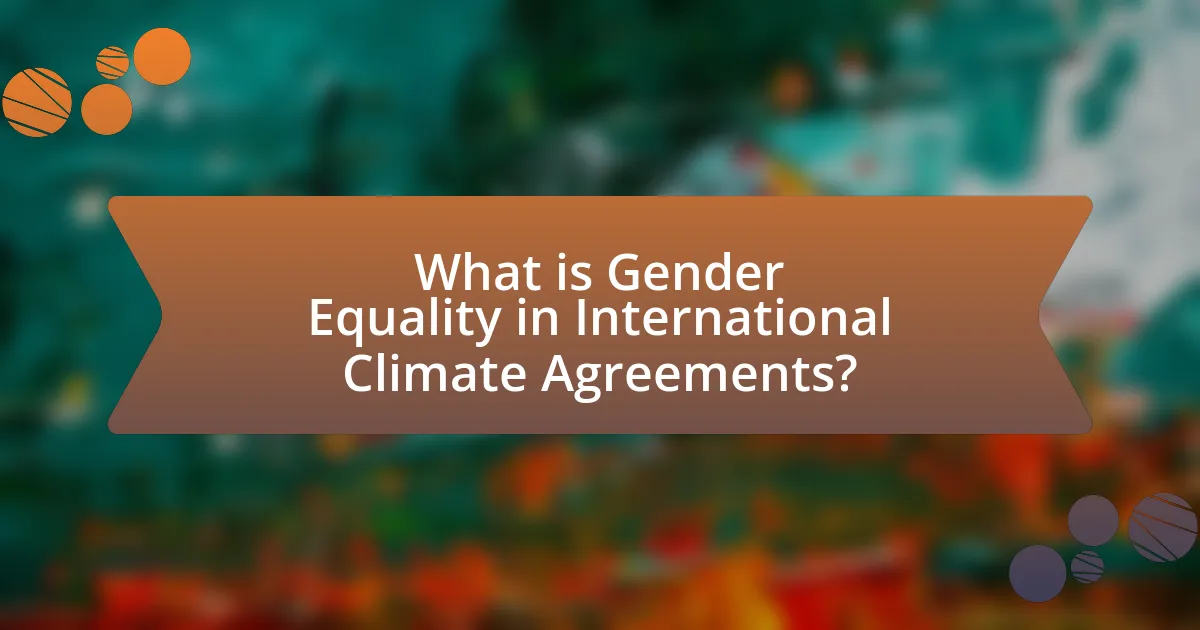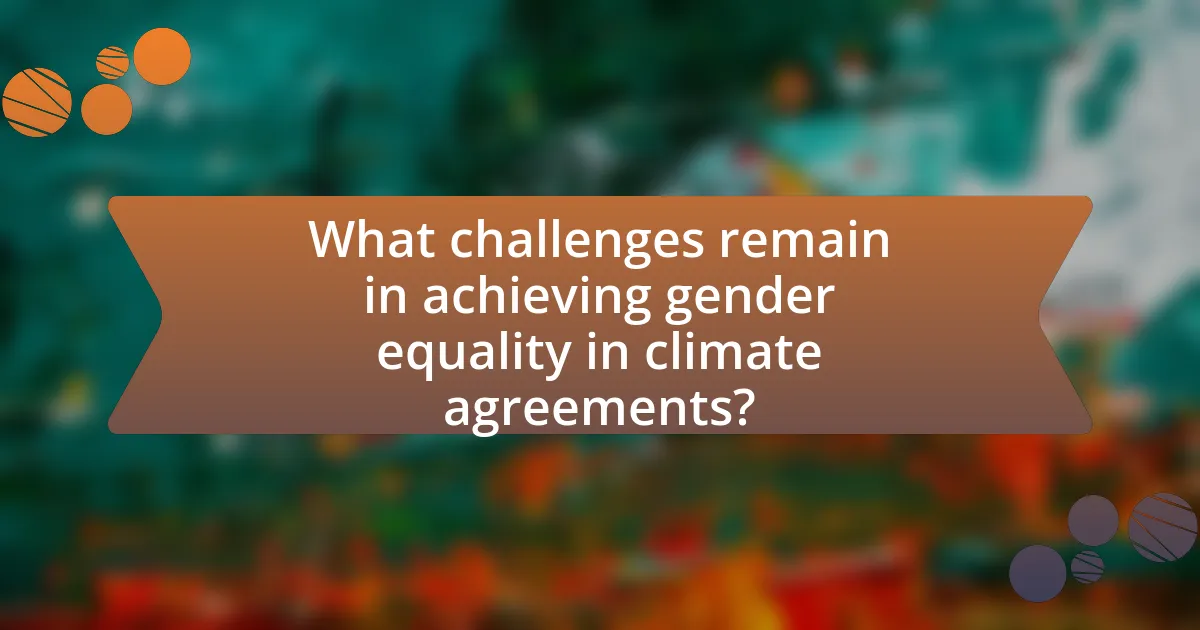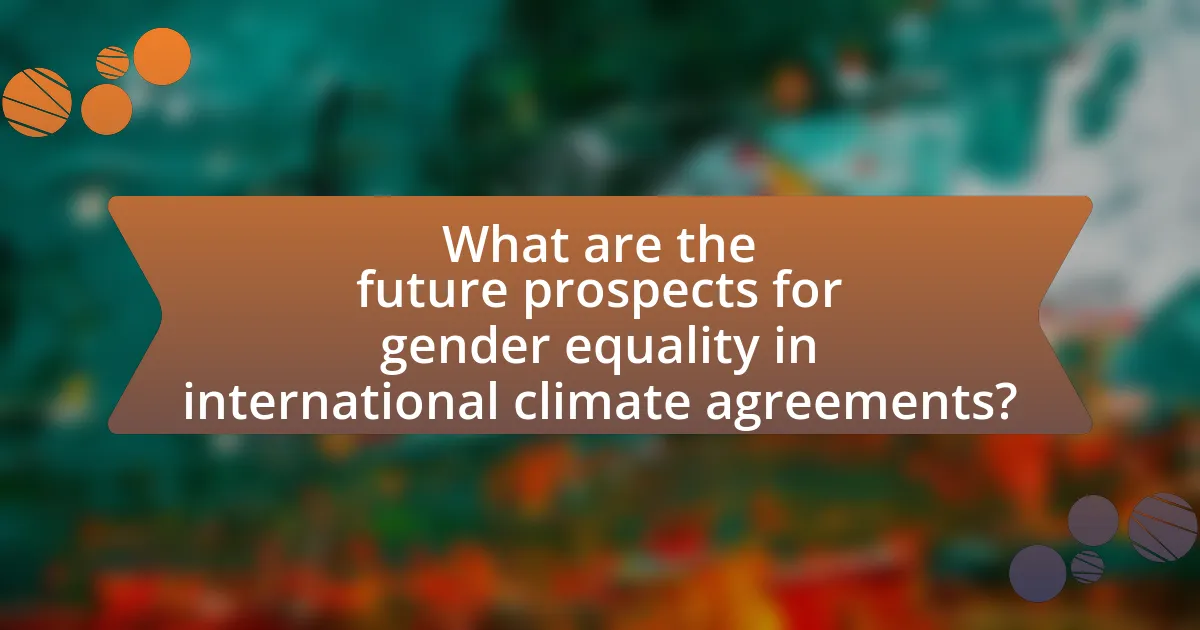Gender equality in international climate agreements is a critical aspect that emphasizes the inclusion of gender considerations in climate policies and decision-making processes. The article outlines the importance of gender equality in enhancing the effectiveness of climate actions, highlighting how women’s participation can lead to more sustainable outcomes. It discusses historical perspectives on gender in climate negotiations, key international agreements like the Paris Agreement and the Gender Action Plan, and the progress made towards integrating gender-responsive policies. Additionally, the article addresses the challenges and barriers that remain, such as insufficient representation and funding, while also exploring future prospects and practical steps to promote gender equality in climate action.

What is Gender Equality in International Climate Agreements?
Gender equality in international climate agreements refers to the recognition and incorporation of gender considerations in climate policies and actions, ensuring equal participation and representation of all genders in decision-making processes. This concept is grounded in the understanding that climate change impacts different genders in distinct ways, often exacerbating existing inequalities. For instance, the United Nations Framework Convention on Climate Change (UNFCCC) emphasizes gender-responsive approaches, highlighting that women’s involvement can enhance the effectiveness of climate actions. Research indicates that countries integrating gender equality into their climate strategies are more likely to achieve sustainable development goals, as evidenced by initiatives like the Gender Action Plan adopted at COP23, which aims to promote gender equality in climate action.
Why is Gender Equality important in the context of climate agreements?
Gender equality is important in the context of climate agreements because it enhances the effectiveness and inclusivity of climate action. Research indicates that women often play a critical role in natural resource management and are disproportionately affected by climate change impacts, making their participation essential for developing comprehensive solutions. For instance, the United Nations Framework Convention on Climate Change (UNFCCC) recognizes that gender-responsive approaches can lead to more sustainable and equitable outcomes, as evidenced by initiatives that have successfully integrated women’s perspectives into climate policies, resulting in improved resilience and adaptation strategies.
How does gender inequality impact climate change responses?
Gender inequality significantly hampers effective climate change responses by limiting women’s participation in decision-making processes. Research indicates that women often possess unique knowledge and skills related to resource management and sustainability, yet they are frequently excluded from leadership roles in climate policy. For instance, a study by the United Nations Framework Convention on Climate Change (UNFCCC) highlights that countries with higher gender equality tend to have more comprehensive climate action plans. This correlation suggests that inclusive governance can enhance the effectiveness of climate strategies, as diverse perspectives lead to more innovative solutions. Therefore, addressing gender inequality is crucial for improving climate change responses and achieving sustainable development goals.
What are the historical perspectives on gender in climate negotiations?
Historical perspectives on gender in climate negotiations reveal a gradual recognition of the importance of gender equality in addressing climate change. Initially, gender considerations were largely absent from climate discussions, with early frameworks like the United Nations Framework Convention on Climate Change (UNFCCC) in 1992 focusing primarily on environmental and economic issues. However, significant milestones occurred, such as the adoption of the Gender Action Plan at the 2017 UN Climate Change Conference, which acknowledged the differentiated impacts of climate change on men and women and aimed to enhance women’s participation in climate decision-making. This shift was supported by research indicating that women’s involvement leads to more effective climate solutions, as highlighted in studies by the Global Gender and Climate Alliance. Over time, gender has become increasingly integrated into climate policies, reflecting a broader understanding of social equity in environmental governance.
What are the key international climate agreements addressing gender equality?
The key international climate agreements addressing gender equality include the Paris Agreement, the Convention on Biological Diversity (CBD), and the United Nations Framework Convention on Climate Change (UNFCCC). The Paris Agreement, adopted in 2015, emphasizes the importance of gender equality and women’s empowerment in climate action, recognizing that gender-responsive approaches can enhance the effectiveness of climate policies. The CBD, particularly through its Gender Plan of Action, aims to integrate gender considerations into biodiversity conservation efforts. The UNFCCC has established a Gender and Climate Change Work Programme, which promotes gender-responsive climate policies and encourages the participation of women in decision-making processes. These agreements collectively highlight the critical role of gender equality in achieving sustainable climate solutions.
How do the Paris Agreement and other frameworks incorporate gender considerations?
The Paris Agreement incorporates gender considerations by recognizing the importance of gender equality in climate action and decision-making processes. Specifically, Article 7 emphasizes the need for inclusive participation, which includes the involvement of women and marginalized groups in climate adaptation and mitigation strategies. Additionally, the Gender Action Plan established at the 2017 UN Climate Change Conference aims to enhance the participation of women and integrate gender perspectives into climate policies. Other frameworks, such as the Convention on Biological Diversity, also promote gender equality by encouraging the involvement of women in biodiversity conservation efforts. These frameworks collectively highlight the necessity of gender-responsive approaches to effectively address climate change impacts.
What specific commitments have been made regarding gender equality in these agreements?
Specific commitments regarding gender equality in international climate agreements include the integration of gender considerations into climate action plans and policies, as outlined in the Paris Agreement. The agreement emphasizes the importance of gender equality in achieving climate goals and encourages parties to promote gender-responsive approaches. Additionally, the Gender Action Plan established at the UN Climate Change Conference in 2017 aims to enhance the participation of women in climate decision-making and to ensure that gender perspectives are included in climate finance and technology transfer. These commitments are supported by various resolutions and decisions made during subsequent COP meetings, reinforcing the necessity of gender equality in climate resilience and adaptation strategies.
What progress has been made towards gender equality in climate agreements?
Significant progress has been made towards gender equality in climate agreements, particularly through the inclusion of gender-responsive policies in international frameworks. The Paris Agreement, adopted in 2015, explicitly recognizes the importance of gender equality and women’s empowerment in climate action, urging parties to consider gender in their climate plans. Additionally, the Gender Action Plan established at the 2017 UN Climate Change Conference aims to enhance the participation of women in climate negotiations and decision-making processes. Evidence of this progress includes the establishment of dedicated gender focal points within climate organizations and the integration of gender considerations into national climate strategies, as reported by the UN Framework Convention on Climate Change.
What initiatives have been launched to promote gender equality in climate action?
Initiatives launched to promote gender equality in climate action include the Gender Action Plan adopted at the UN Climate Change Conference (COP23) in 2017, which aims to enhance the participation of women in climate decision-making and ensure gender-responsive climate policies. Additionally, the Women and Gender Constituency, part of the UNFCCC, advocates for gender equality in climate negotiations and promotes women’s leadership in climate solutions. The Global Gender and Climate Alliance also works to integrate gender considerations into climate policies and programs. These initiatives are supported by evidence showing that women’s involvement in climate action leads to more effective and sustainable outcomes, as highlighted in various reports by the UN and other organizations.
How have countries implemented gender-responsive policies in climate strategies?
Countries have implemented gender-responsive policies in climate strategies by integrating gender considerations into national climate action plans and policies. For instance, countries like Sweden and Canada have established frameworks that mandate gender analysis in climate-related decision-making processes, ensuring that women’s voices and needs are prioritized. Additionally, the United Nations Framework Convention on Climate Change (UNFCCC) encourages parties to adopt gender-responsive approaches, leading to initiatives such as the Gender Action Plan, which aims to enhance the participation of women in climate negotiations and implementation. These efforts are supported by evidence showing that gender-responsive policies can lead to more effective climate action and resilience-building, as women’s involvement often results in innovative solutions and improved community outcomes.

What challenges remain in achieving gender equality in climate agreements?
Challenges in achieving gender equality in climate agreements include insufficient representation of women in decision-making processes, lack of gender-responsive policies, and inadequate funding for gender-focused climate initiatives. Women are often underrepresented in climate negotiations, with only 30% of delegates being female in recent conferences, limiting their influence on policy outcomes. Additionally, many climate agreements do not incorporate gender considerations, which hinders the effectiveness of climate actions. Funding for initiatives that specifically address the intersection of gender and climate change remains low, with only 1% of climate finance directed towards gender equality efforts. These factors collectively impede progress towards gender equality in climate agreements.
What barriers hinder the integration of gender perspectives in climate policies?
Barriers hindering the integration of gender perspectives in climate policies include lack of political will, insufficient data on gender and climate interactions, and inadequate representation of women in decision-making processes. Political will is often weak due to entrenched gender norms and priorities that overlook gender issues in climate discussions. Furthermore, the absence of comprehensive data makes it challenging to understand the specific impacts of climate change on different genders, which limits the formulation of targeted policies. Lastly, women’s underrepresentation in leadership roles within climate negotiations and policy-making bodies restricts their voices and perspectives from being included, perpetuating gender biases in climate action.
How do cultural and societal norms affect gender equality in climate negotiations?
Cultural and societal norms significantly impact gender equality in climate negotiations by shaping the roles and perceptions of women in decision-making processes. In many cultures, traditional gender roles limit women’s participation in political and environmental discussions, leading to underrepresentation in negotiations. For instance, a study by the United Nations Framework Convention on Climate Change (UNFCCC) found that women’s participation in climate negotiations is often hindered by societal expectations that prioritize male leadership and decision-making. Additionally, norms that devalue women’s contributions to environmental management further exacerbate gender disparities, resulting in policies that do not adequately address the needs and perspectives of women. This systemic inequality not only affects the effectiveness of climate agreements but also undermines the potential for inclusive and equitable solutions to climate challenges.
What role does funding play in supporting gender equality initiatives in climate action?
Funding is crucial in supporting gender equality initiatives in climate action by providing the necessary resources to implement programs that empower women and promote their participation in climate decision-making. Financial investments enable the development of gender-responsive policies and projects that address the unique challenges faced by women in the context of climate change. For instance, the Global Environment Facility has allocated funds specifically for projects that integrate gender considerations into climate adaptation and mitigation strategies, demonstrating the effectiveness of targeted funding in achieving gender equality outcomes.
How can the challenges to gender equality in climate agreements be addressed?
To address the challenges to gender equality in climate agreements, it is essential to integrate gender-responsive policies and frameworks into climate action plans. This integration can be achieved by ensuring equal representation of women in decision-making processes, which has been shown to enhance the effectiveness of climate policies. For instance, research by the United Nations Framework Convention on Climate Change (UNFCCC) indicates that countries with higher female participation in climate negotiations tend to adopt more comprehensive and inclusive climate strategies. Additionally, providing targeted funding and resources for women’s initiatives in climate adaptation and mitigation can empower women and promote gender equality.
What best practices can be adopted to enhance gender inclusivity in climate policies?
To enhance gender inclusivity in climate policies, best practices include integrating gender analysis into policy development, ensuring equal representation in decision-making processes, and promoting gender-responsive budgeting. Integrating gender analysis allows policymakers to understand the different impacts of climate change on various genders, leading to more effective solutions. Equal representation ensures that women’s voices and perspectives are included, which is crucial for creating comprehensive climate strategies. Gender-responsive budgeting allocates resources in a way that addresses the specific needs of all genders, thereby promoting equity in climate action. These practices are supported by evidence from the United Nations Framework Convention on Climate Change, which emphasizes the importance of gender equality in achieving sustainable development goals.
How can stakeholders collaborate to overcome existing barriers?
Stakeholders can collaborate to overcome existing barriers by establishing inclusive dialogue platforms that facilitate communication and shared decision-making. These platforms enable diverse voices, particularly those of marginalized groups, to contribute to climate agreements, ensuring that gender perspectives are integrated into policy frameworks. Research indicates that inclusive participation leads to more effective climate action, as seen in the 2015 Paris Agreement, which emphasized the importance of gender equality in achieving climate goals. By fostering partnerships among governments, NGOs, and local communities, stakeholders can leverage resources and expertise, ultimately enhancing the effectiveness of climate initiatives and addressing gender disparities.

What are the future prospects for gender equality in international climate agreements?
The future prospects for gender equality in international climate agreements are increasingly positive, driven by growing recognition of the importance of gender considerations in climate policy. Recent initiatives, such as the Gender Action Plan adopted at the UN Climate Change Conference, emphasize the need for integrating gender perspectives into climate actions. Furthermore, research indicates that countries that prioritize gender equality in climate strategies tend to achieve better environmental outcomes, as women often play crucial roles in sustainable practices. This trend suggests that future agreements may increasingly incorporate gender-responsive measures, enhancing both equity and effectiveness in climate action.
How can emerging trends influence gender equality in climate action?
Emerging trends can significantly influence gender equality in climate action by promoting inclusive policies and practices that recognize and address the unique vulnerabilities and contributions of women in climate-related issues. For instance, the integration of gender-responsive approaches in climate finance and policy-making ensures that women’s voices are included, leading to more equitable outcomes. Research from the United Nations Framework Convention on Climate Change (UNFCCC) highlights that countries implementing gender-responsive climate policies have seen improved resilience and adaptive capacity among women, which reinforces the importance of gender equality in achieving effective climate action.
What role does technology play in promoting gender equality in climate initiatives?
Technology plays a crucial role in promoting gender equality in climate initiatives by providing tools and platforms that empower women and enhance their participation in decision-making processes. For instance, digital platforms facilitate access to information and resources, enabling women to engage in climate action effectively. According to the United Nations Framework Convention on Climate Change (UNFCCC), integrating gender-responsive approaches in climate policies leads to more effective outcomes, as women often possess unique knowledge and skills related to environmental management. Furthermore, technologies such as mobile applications and social media have been instrumental in raising awareness and mobilizing communities around gender and climate issues, thereby fostering inclusive participation.
How can youth and grassroots movements impact gender equality in climate agreements?
Youth and grassroots movements can significantly impact gender equality in climate agreements by advocating for inclusive policies and raising awareness about the unique challenges faced by women in climate change. These movements mobilize communities, influence policymakers, and ensure that women’s voices are represented in climate negotiations. For instance, the 2019 UN Climate Change Conference saw youth activists, including Greta Thunberg, emphasize the need for gender-responsive climate action, highlighting that women are disproportionately affected by climate impacts. Research indicates that when women participate in decision-making processes, the outcomes are more effective and equitable, as evidenced by the UN’s Gender and Climate Change report, which states that gender-inclusive policies lead to better environmental management and resilience.
What practical steps can be taken to promote gender equality in climate agreements?
To promote gender equality in climate agreements, countries should implement gender-responsive policies and ensure women’s participation in decision-making processes. This can be achieved by mandating gender analysis in climate action plans, allocating resources specifically for women’s initiatives, and establishing quotas for women’s representation in climate negotiations. Evidence from the United Nations Framework Convention on Climate Change (UNFCCC) indicates that countries with higher female representation in climate policy-making tend to adopt more comprehensive and effective climate strategies. Additionally, integrating gender considerations into climate finance mechanisms can enhance the effectiveness of funding and support for vulnerable communities, further promoting gender equality.
What resources are available for advocates of gender equality in climate action?
Advocates of gender equality in climate action can access various resources, including reports, toolkits, and networks. Notable resources include the Gender and Climate Change Toolkit by the United Nations Development Programme, which provides practical guidance for integrating gender into climate policies. Additionally, the Women’s Environment and Development Organization offers research and advocacy tools focused on women’s roles in climate action. The Global Gender and Climate Alliance serves as a network for sharing best practices and fostering collaboration among stakeholders. These resources are essential for empowering advocates and enhancing gender-responsive climate initiatives.
How can individuals contribute to advancing gender equality in climate policies?
Individuals can contribute to advancing gender equality in climate policies by actively participating in advocacy, education, and decision-making processes. Engaging in local and global forums allows individuals to voice the importance of integrating gender perspectives into climate strategies. Research indicates that women’s involvement in climate decision-making leads to more effective and equitable outcomes, as seen in the United Nations Framework Convention on Climate Change, which emphasizes gender-responsive approaches. By supporting organizations that promote women’s rights in environmental contexts, individuals can help ensure that gender equality is prioritized in climate policies.
